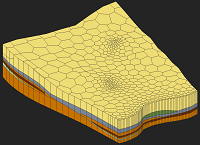GMS:UGrid Display Options: Difference between revisions
From XMS Wiki
Jump to navigationJump to search
No edit summary |
No edit summary |
||
| Line 15: | Line 15: | ||
| Inactive points || Show points that correspond with an inactive dataset value.{{Version GMS 10.1}} | | Inactive points || Show points that correspond with an inactive dataset value.{{Version GMS 10.1}} | ||
|- | |- | ||
| UGrid shell || The UGrid shell item is used to display an edge for each of the edges on the exterior of the set of all cells (visible or invisible) which corresponds to a discontinuity in the UGrid exterior. This display option provides a helpful spatial context when displaying | | UGrid shell || The UGrid shell item is used to display an edge for each of the edges on the exterior of the set of all cells (visible or invisible) which corresponds to a discontinuity in the UGrid exterior. This display option provides a helpful spatial context when displaying isosurfaces or cross sections. | ||
|- | |- | ||
| Feature angle || The UGrid shell feature angle is used only when the UGrid Shell option is selected. This angle represents a threshold angle at which an edge of the shell will be displayed. If for example, an angle of 45 degrees is defined, any edge of the UGrid which divides two cell faces that are at an angle greater than 45 degrees to each other will not be displayed. | | Feature angle || The UGrid shell feature angle is used only when the UGrid Shell option is selected. This angle represents a threshold angle at which an edge of the shell will be displayed. If for example, an angle of 45 degrees is defined, any edge of the UGrid which divides two cell faces that are at an angle greater than 45 degrees to each other will not be displayed. | ||
